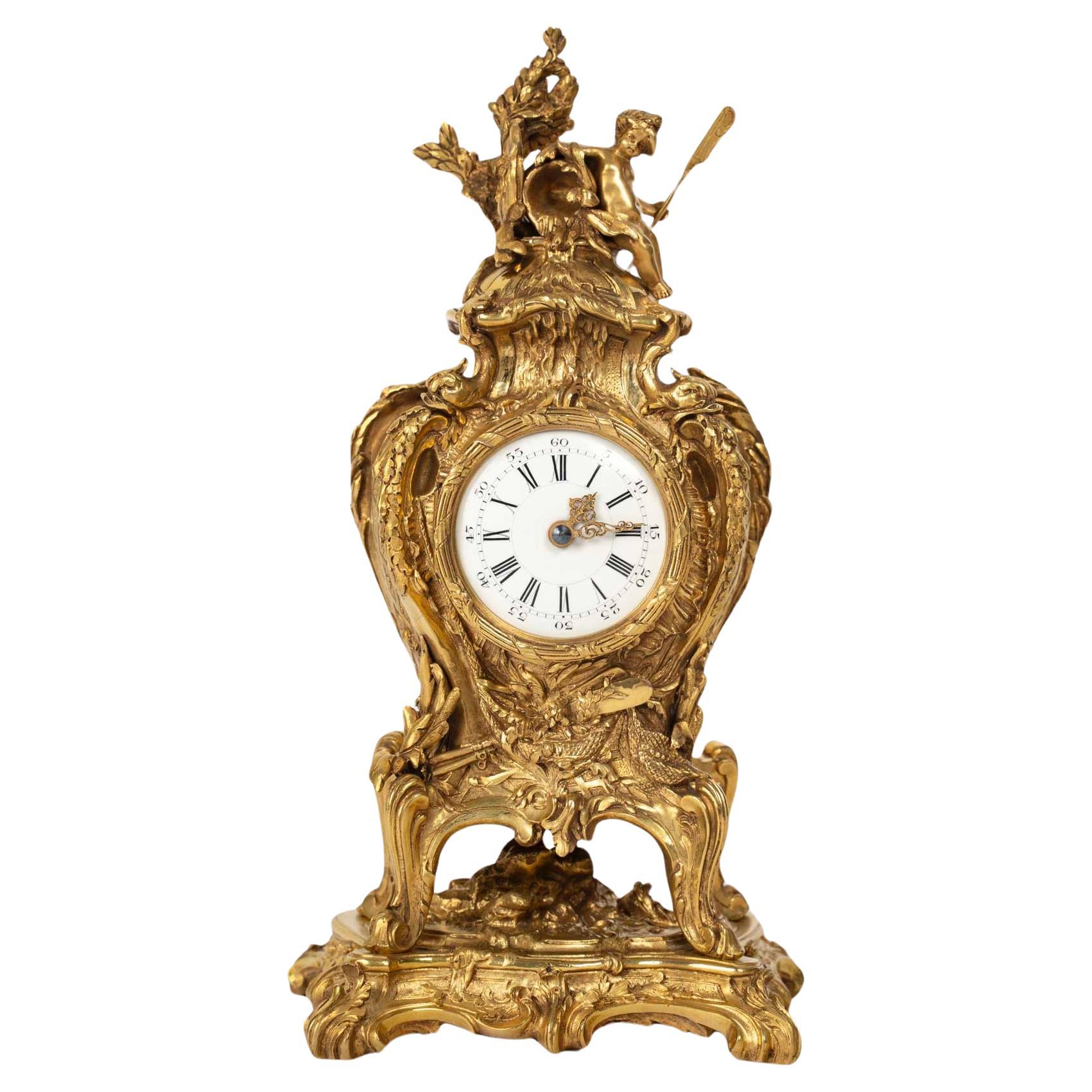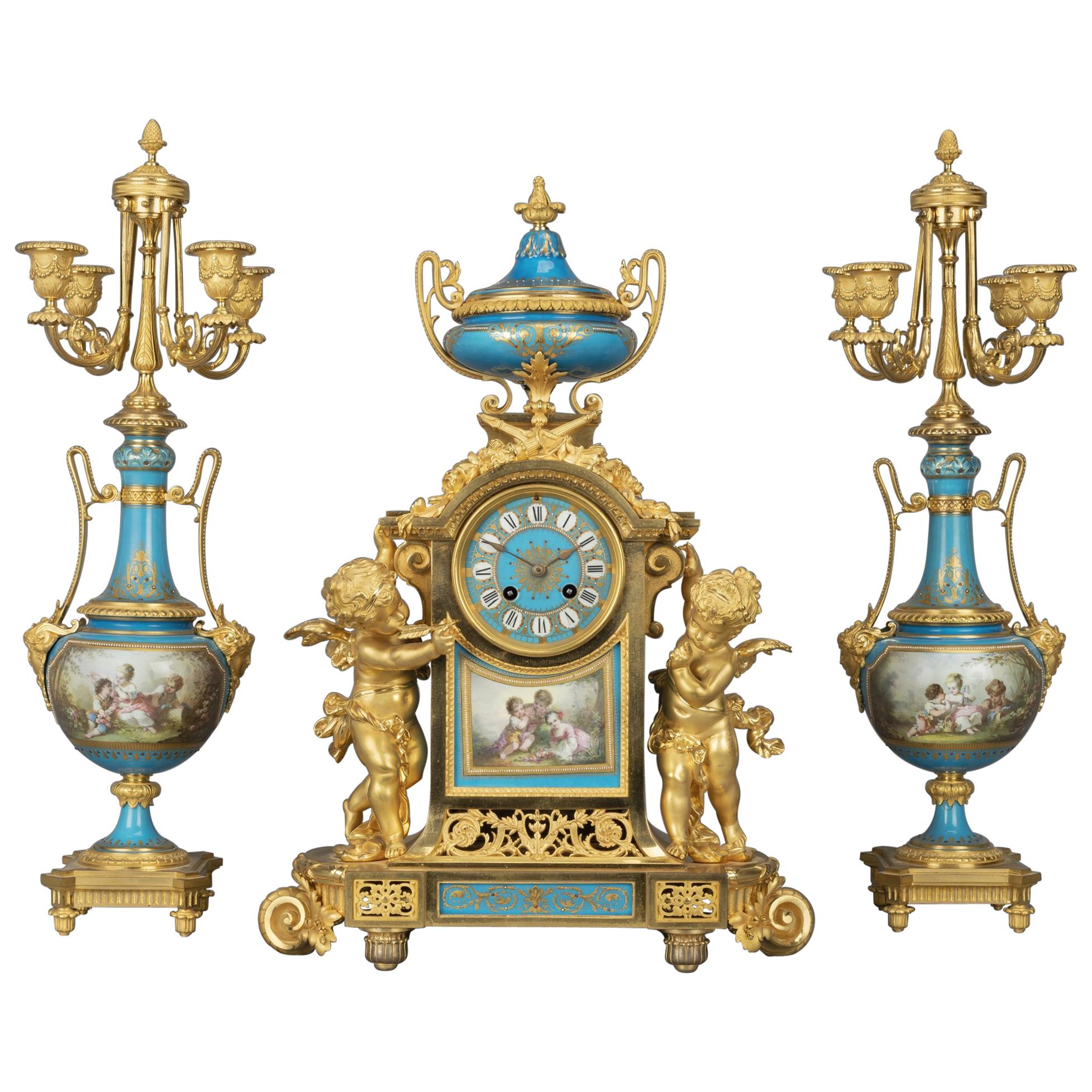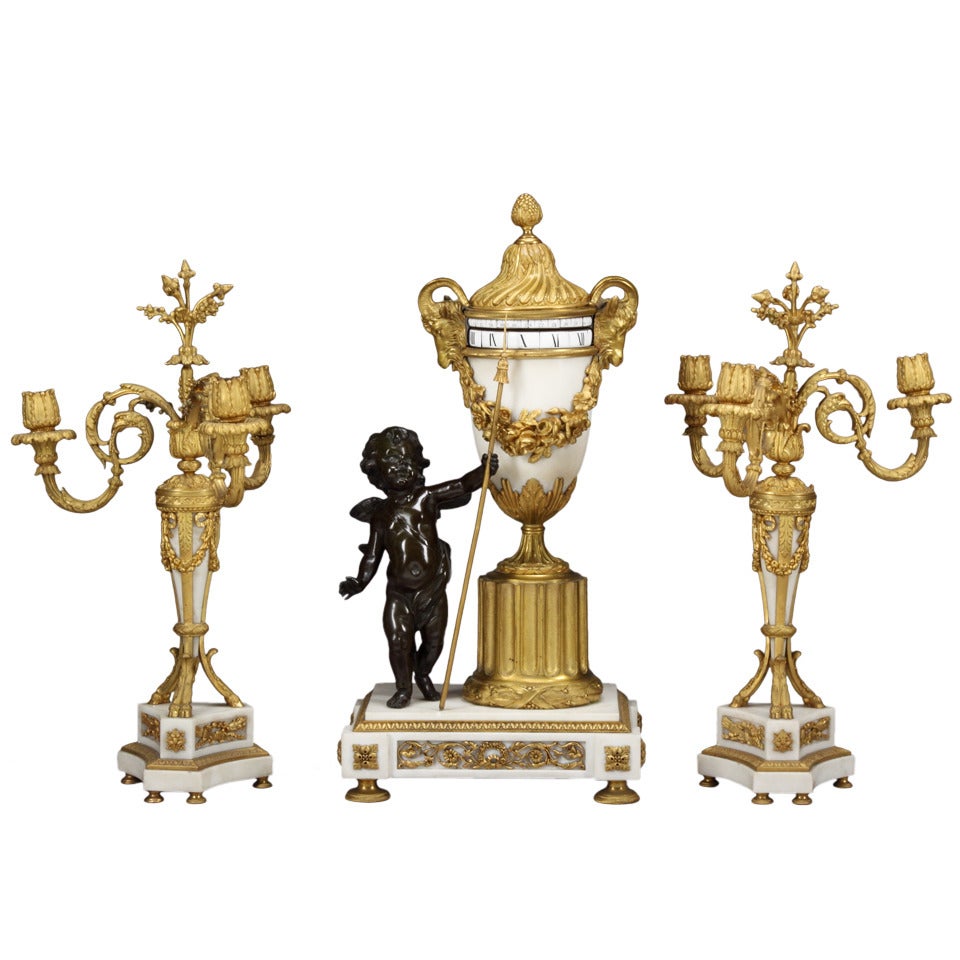Items Similar to A French ‘Chariot’ Three-pieces Clock Garniture attributed to F.Linke circa 1890
Want more images or videos?
Request additional images or videos from the seller
1 of 17
A French ‘Chariot’ Three-pieces Clock Garniture attributed to F.Linke circa 1890
About the Item
A French Ormolu and Patinated-Bronze ‘Chariot’ Three-pieces Clock Garniture
Attributed to François Linke (1855 - 1946), Paris, Late 19th/ Century
The clock representing a putto on a chariot pulled by a winged female bust with turban, on 'C'-scrolled acanthus and rocaille decorated base,
The wheel-shaped dial with blue enamel Roman chapters, the twin-barrel movement with platform lever escapement with strike to bell, signed 'CCH and numbered 1846
With winding key and regulating key.
Together with a real pair of pendant candelabras, designed as a couple of putti.
This whimsical mantle clock, loosely in the form of a chariot or gondola, is in the high Rococo style of the sculptor Léon Messagé as promoted in his Cahier des Dessins et Croquis Style Louis XV, 1890. Messagé’s designs of asymmetry rocaille created 'le style Linke' for which Linke’s stand at the Paris 1900 Exposition universelle was so applauded.
Original gilding
Clock H 40,5 cm L 37,5 cm P 20 cm
Candelabras H 37,5 cm L 25 cm P 20 cm
A similar clock, signed F.Linke, smaller, 12 in. (30.5 cm.) high; 11 ½ (9 cm.) wide; 7 in. (18 cm.) deep. was sold in Christie’s London, 6th March 2014
François Linke (1855 - 1946) was the most important Parisian cabinet maker of the late nineteenth and early twentieth centuries, and possibly the most sought-after cabinet maker of his period.
He was born in 1855 in the small village of Pankraz, in what is now the Czech Republic. Records show that Linke served an apprenticeship with the master cabinetmaker Neumann, then in 1875 at the age of 20 he arrived in Paris where he lived until he died in 1946.
It is known that the fledgling Linke workshops were active in Paris in the Faubourg St. Antoine as early as 1881, and during this time he supplied furniture for other more established makers such as Jansen and Krieger.
The quality of Linke's craftsmanship was unsurpassed by any of his contemporaries and reached its peak with his spectacular stand at the Paris Exposition Universelle in 1900, where his Grand Bureau took the gold medal. He gambled his fortune and reputation on this stand, exhibiting several breathtaking items of furniture with sculptural mounts of the most exceptional quality and proportion. His gamble worked and his reputation was established to such an extent that Linke continued to be the pre-eminent furniture house in Paris until the Second World War.
As the Art Journal reported in 1900 on Linke's stand:
'The work of M. Linke ... was an example of what can be done by seeking inspiration amongst the classic examples of Louis XV and XVI without in any great sense copying these great works. M. Linke's work was original in the true sense of the word, and as such commended itself to the intelligent seeker after the really artistic things of the Exhibition. Wonderful talent was employed in producing the magnificent pieces of furniture displayed....'
The formation of Linke's distinctive style was made possible by his collaboration with the sculptor Léon Messagé. Together Linke and Messagé designed furniture for Linke's 1900 exhibition stand, with exuberant allegorical figures cast in high relief, that exemplified Linke's ability to seamlessly merge the different mediums of wood carving, bronze and marquetry into a dynamic unified whole.
- Attributed to:François Linke (Maker)
- Dimensions:Height: 15.95 in (40.5 cm)Width: 14.77 in (37.5 cm)Depth: 7.88 in (20 cm)
- Sold As:Set of 3
- Style:Napoleon III (Of the Period)
- Materials and Techniques:
- Place of Origin:
- Period:
- Date of Manufacture:circa 1890
- Condition:Wear consistent with age and use.
- Seller Location:Saint-Ouen, FR
- Reference Number:1stDibs: LU2612338341762
About the Seller
4.9
Vetted Seller
These experienced sellers undergo a comprehensive evaluation by our team of in-house experts.
1stDibs seller since 2017
56 sales on 1stDibs
Typical response time: 1 hour
- ShippingRetrieving quote...Ships From: Saint-Ouen, France
- Return PolicyA return for this item may be initiated within 2 days of delivery.
More From This SellerView All
- Attributed to L.Messagé (1842-1901) and F.Linke, "Source Allegory" ClockBy François LinkeLocated in Saint-Ouen, FRAttributed to Leon Messagé (1842-1901) and François Linke (1855-1946) Gilt bronze clock surmounted by an allegory of the Source. With rocaille decoration, resting on four cambered l...Category
Antique 1890s French Napoleon III Table Clocks and Desk Clocks
MaterialsOrmolu, Enamel
- A French Napoléon III Ormolu Cartel Clock by Susse Frères Paris circa 1870By Susse FreresLocated in Saint-Ouen, FRA French 19th Century Cornucopia Gilt-Bronze Cartel, by Susse Frères Paris An Ormolu Cartel in the shape of an escutcheon, with a circular white enamel dial, signed Susse Frères/A Paris, Arabic numerals for the hours and for the minutes. It's bordered by a frieze of pearls and surmounted by a falling laurel knot with a drapery in the lower part and flanked by cornucopias adorned with flowers and fruits. Rectangular base decorated with a garland of knotted flowers dying in a tapered, fluted barrel and damping, in the upper part, a flowery Medici vase. Louis XVI Style Circa 1870 Original gilding uncleaned The Susse company, a worldwide reknown foundry, began to cast pieces as soon as the first half of the 19th Century. Awarded medals...Category
Antique 1860s French Louis XVI Wall Clocks
MaterialsOrmolu
- Fannières Frères Desk Clock "Time Allegory" circa 1860By Fannière FrèresLocated in Saint-Ouen, FRFannières Frères Desk Clock Time Allegory Chased gilt and silvered bronze Desk Clock With an allegorical theme of Time in the form of a cherub suppor...Category
Antique 1860s French Louis XVI Table Clocks and Desk Clocks
MaterialsMarble, Bronze, Ormolu
- Very Impressive French 19th Century Neoclassical Lyre-Form ClockBy Etienne LeNoirLocated in Saint-Ouen, FRAn impressive French 19th century Neoclassical Lyre-form clock with jeweled pendulum. Amazing quality white and yellow marble 19th century French Lyre-Form clock mounted all over with gilt bronze...Category
Antique 1850s French Louis XVI Mantel Clocks
MaterialsCrystal, Marble, Enamel, Ormolu
- French 19th Century Aesthetic Movement Chinoiserie Timepiece by Susse FrèresBy L'Escalier de Cristal, Susse FreresLocated in Saint-Ouen, FRA very fine bronze brown and gilt patina French 19th century timepiece in the oriental Chinese taste. In an Archaic style bell with molded relief dragons circling body, surmounted by...Category
Antique 1860s French Chinoiserie More Clocks
MaterialsBronze
- A Very Fine Quality 19th Century French Pair of CandlesticksLocated in Saint-Ouen, FRVery Fine French 19th Century Pair of Candlesticks In ormolu, very finely chiseled and decorated with knotted garlands, branches of leafy flowers, spokes of hearts, leaves of water...Category
Antique 1870s French Louis XVI Candlesticks
MaterialsOrmolu
You May Also Like
- Three Piece French Bronze and Marble Clock Garniture, circa 1875Located in New York, NYThree piece French bronze and marble clock garniture, circa 1875.Category
Antique 1870s French Table Clocks and Desk Clocks
MaterialsMarble, Bronze
- Important Napoléon III Gilt-Bronze and Porcelain Clock Garniture, circa 1870Located in Brighton, West SussexAn important Napoléon III gilt bronze and turquoise porcelain clock garniture. French, circa 1870. This very fine clock garniture comprises of a clock and a pair of vase form candelabra. The finely cast and chiselled gilt bronze case has a jewelled turquoise porcelain face with Roman Numerals above a plaque depicting children in a wooded landscape, flanked by expressive male and female cherub figures, cast in the round, beneath a scrolled pediment with torches en flambeau and surmounted by a turquoise vase and cover. The pair of candelabra en-suite are in the form of turquoise porcelain vases...Category
Antique Late 19th Century French Napoleon III Mantel Clocks
MaterialsBronze
- French Régence Style Gilt Bronze Clock GarnitureLocated in London, GBFrench Régence style gilt bronze clock garniture French, late 19th century Clock: Height 60cm, width 36cm, depth 20cm Candelabra: Height 67cm, width 25cm, depth 25cm This wonde...Category
Antique Late 19th Century French Mantel Clocks
MaterialsBronze, Ormolu
- Belgian Empire Gilt Metal Three-Piece Garniture Clock Candelabras SetLocated in Germantown, MDBelle Epoque Belgian Empire style Gilt Metal Three-Piece candelabras and Clock Garniture set with Asian inspiration. They measures 11" in width,...Category
Early 20th Century Belgian Empire Candelabras
MaterialsBrass
- Unusual 19th Century French rotary Clock GarnitureLocated in Los Angeles, CAA rare and very fine 19th century French Louis XVI style ormolu mounted white marble 3-piece Rotary (Annular) clock set comprising a clock and a pair of 3 arms candelabra. The urn s...Category
Antique 19th Century French Louis XVI Clocks
MaterialsMarble, Ormolu
- Louis XV Style Bronze Figural Clock Garniture by Maison Baguès French circa 1870By Maison BaguèsLocated in Brighton, West SussexA fine Louis XV style gilt and Patinated bronze figural clock garniture by Maison Baguès. This rare example of a clock garniture by Maison Baguès has a twin train eight-day movement striking on a bell. The garniture consists of a clock and a pair of candelabra en suite. The clock has a Rococo cast case surmounted by a patinated bronze putto playing a lyre, above a circular white enamel dial with Roman numerals, Arabic seconds and pierced hands. The dial inscribed 'Eug Bagues, Paris'. The case terminates in four scrolling legs put down on an acanthus cast plinth base. The candelabra en suite have gilt bronze pierced acanthus cast bases supporting patinated bronze putti each holding aloft three scrolling acanthus arms terminating in circular and foliate cast drip trays and nozzles. Maison Baguès The Baguès Company, located at 31, rue des Francs-Bourgeois, was founded in 1840 by Mr. Noel Baguès who started his business to cast liturgical bronzes. By 1880 the company had expanded into the production of bronze light fixtures in response to the development of electrical lighting. Carried on by Noël’s son Eugène and grandsons Victor and Robert, Maison Baguès continued to progress, adding intricately detailed iron lighting collections in the 1920s as well as stair banisters...Category
Antique Mid-19th Century French Louis XV Mantel Clocks
MaterialsBronze
Recently Viewed
View AllMore Ways To Browse
Watches Depose Paris
Marble Dial Clocks
Stickley Clock
Angevin A Paris
Porcelain Sitzendorf Clock
Wooden Dial
Three Gilt Cherubs
Tiffany Bird Nest
Vintage Kieninger Mantel Clock
Wagstaffe Clock
York Minster Skeleton Clock
Ansonia Mantel Clock Key
Antique Ingram Clocks
Antique Seth Thomas Adamantine Mantel Clock
Chelsea Mantel Clock Tiffany
Clio Desk
Clock Dail
En Welch Antique Mantel Clocks





